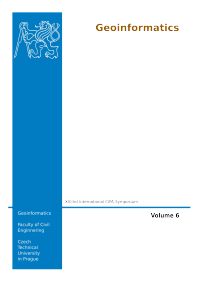Surveying and Comparing the Arco Dei Gavi and its Historical Wooden Maquette
DOI:
https://doi.org/10.14311/gi.6.42Keywords:
laser scanning, 3D modelling, digital photogrammetry, cultural heritage, virtual anastylosis, preservation, documentation.Abstract
Actually geometrics’ science offers new opportunities and interesting applications in the field of Cultural Heritage. These applications are strictly related to preservation, restoration but even to cataloging and reproducing a monument that no longer has its original integrity. The possibility of obtaining 3D data, of such a model close to reality, enables us to realize studies that sometimes are too complex or impossible. The paper will describe the study of a monumental arch, the Arco dei Gavi, built in Verona during the I sec. A.C., that was destroyed in 1805 by the Napoleonic army, and its wooden model that was realized in 1813 and it has a very important role concerning the monument’s reconstruction. The purpose is to realize two threedimensional models which can be comparable to each other, two models with recognizable differences, similarities and discontinuities about shapes and single elements that compose the monument. It should also be noted that some original parts of the monument have not been relocated but are badly preserved in a museum: the 3D digital model helps to identify these parts in their original location. The main steps of the work can be summarized in: collecting the historical documentation of Arco dei Gavi and its representations; identifying proper instruments (laser scanning and photogrammetric hardware and software); surveying the Arch and its wooden model; identifying a unique and shared reference system; comparing both digital models related to the same scale; choosing a three-dimensional representation to emphasize the results; reallocation of outstanding pieces (virtual anastylosis).References
Adami A., Guerra F., Vernier P., 2007 "Laser scanner and architectural accuracy test" in Proceeding of Cipa 2007 XXI International Symposium "Anticipating the future of the cultural past" Atene
Adami A., Gnesutta M., Vernier P. 2010,Dalla scansione laser al modello: il caso esemplare di San Francesco della Vigna, in Architettura delle facciate: le chiese di Palladio a Venezia. Nuovi rilievi, storia, materiali. Marsilio Editore
Balletti C., Guerra F., Vernier P., Studnicka N., Riegl J., Orlandini S., 2004. Practical comparative evaluation of an integrated hybrid sensor based on Photogrammetry and Laser Scanning for Architectural Representation, in ISPRS, International Archives of Photogrammetry and Remote Sensing, Commission V, ISPRS XX Congress, Istanbul, Turchia.
Bitelli G., Tini M.A., Vittuari L., 2000. Close-range photogrammetry, virtual reality and their intergration in archaeology. In Proceedings of XIXth Congress of International Archives of photogrammetry and remote sensing, pp 872-879, Amsterdam
Boehler W. 2003 Comparing different laser scanners: features, resolution, accuracy. In CISM, International Centre for Mechanical Sciences, Udine.
Guidi G., Beraldin J.A., 2004. Acquisizione 3D e modellazione poligonale. Dall’oggetto fisico al suo calco digitale, Edizioni Poli.Design, Milano.
Downloads
Published
Issue
Section
License
- Authors retain copyright and grant the journal right of first publication with the work simultaneously licensed under a Creative Commons Attribution License that allows others to share the work with an acknowledgement of the work's authorship and initial publication in this journal.
- Authors are able to enter into separate, additional contractual arrangements for the non-exclusive distribution of the journal's published version of the work (e.g., post it to an institutional repository or publish it in a book), with an acknowledgement of its initial publication in this journal.
- Authors are permitted and encouraged to post their work online (e.g., in institutional repositories or on their website) prior to and during the submission process, as it can lead to productive exchanges, as well as earlier and greater citation of published work (See The Effect of Open Access).

